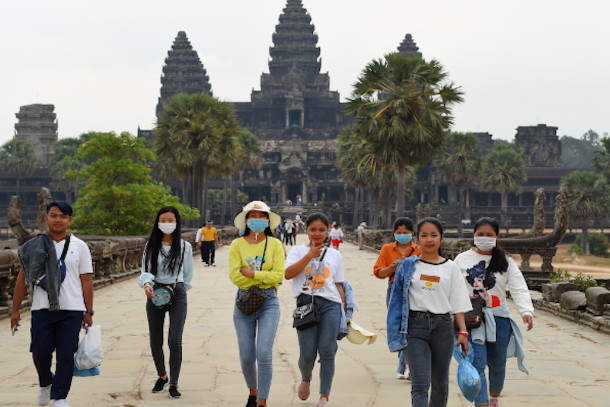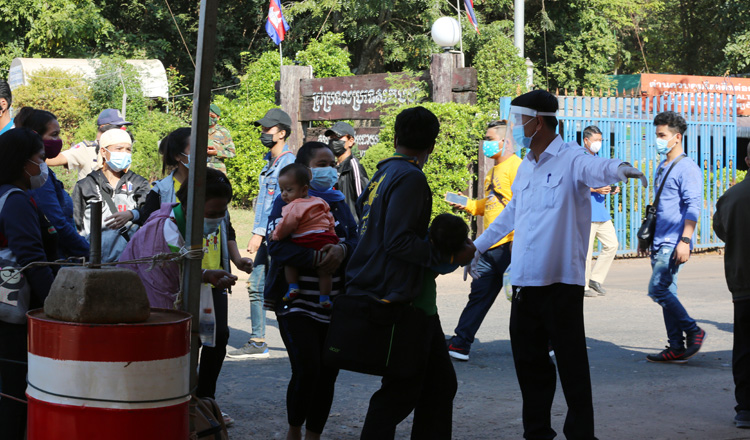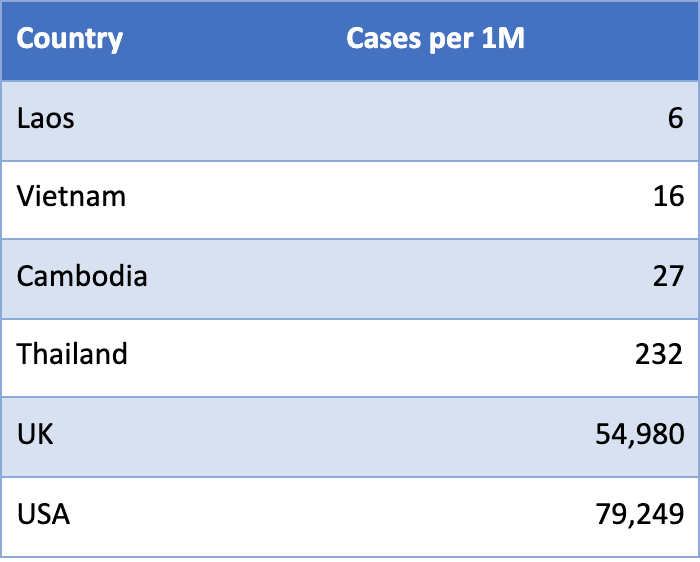
- Cambodia has tested 434,424 people for COVID-19, of whom only 479 tested positive and no deaths.
- Medical experts attribute it largely due to the government’s Pandemic Preparedness and Mitigation Plan.
- Research of Phnom Penh-based data specialist David Benaim suggests that 24 out of the 25 countries with the lowest number of COVID cases per million are situated between the Tropic of Cancer and the Tropic of Capricorn
- Some believe Vitamin D exposure can help prevent COVID-19 infections but Beanaim says that tropical climates can’t totally explain low case counts, as in the case of Philippines and Indonesia
- Furhter, most of Cambodia’s tests are done in conjunction with the internationally-accredited Pasteur Institut du Cambodge (IPC) following all guidelines from the WHO
- Experts have attributed the success of Cambodia to the government’s decision to tighten up the borders, strict quarantine measures that kept tourists away, keeping the possibility of outside infections low.
The COVID-19 pandemic has ruined countries across the world putting at stake their economy, livelihoods and lives in jeopardy. Till date 109 million cases of COVID-19 have been reported from across the world with 2.41 million people reported to have died due to COVID-19. There are hardly few countries who have managed to report zero deaths. Cambodia is one of them with Laos being the other in the region.
Cambodia has successfully managed to keep the number of positive cases low with no deaths. The Kingdom has tested 434,424 suspeced people, of whom only 479 tested positive, giving the country a positive test rate of 0.11 percent.
Cambodia’s 28 cases per one million people rate is the third-lowest in the world, behind Vietnam and Laos, according to Worldometers. By contrast, the United States – the country with the most positive cases in the world – has administered 335,113,418 tests resulting in 28,261,470 positive cases, giving the country a positive rate of 8.4 percent.
Medical experts attribute it largely due to the government’s Pandemic Preparedness and Mitigation Plan.
Credit to government’s Pandemic Preparedness
This week one year ago saw Cambodia import its first Covid-19 case, with only three threats of in-country transmissions since then. From March to mid-April there were a reported 22 local infections before a long pause. Two in-country outbreaks in November were thwarted by swift government action thanks to the commendable rapid assessment and rapid containment approach by the Ministry of Health supported by Institut Pasteur du Cambodge and the World Health Organisation.
Closure of schools and entertainment venues were imposed three times but full lockdown was never imposed as shops, markets, and eateries were kept open.

(Image source: Khmer Times)
Phnom Penh-based data specialist David Benaim has spent recent months trawling through scattered information on Covid-19 in Cambodia. A year since the Kingdom reported its first case, his research provides a surprisingly positive public health outlook. Benaim who has created interactive visuals with the data believes it’s unlikely there are many unreported cases in the country.
Speaking to Khmer Times, Benaim says “Cambodia ranks third lowest in the world in this regard [positive cases divided by the number of tests] with 1.1 tests returning a positive result from every 1,000 tests, implying that should undetected cases exist, they are likely very low.” When asked why he thought Cambodia’s numbers were low, he said there is no way to truly know, but pointed to trends that could lead to further understanding.
Benaim says that 24 out of the 25 countries with the lowest number of COVID cases per million (using Worldometer statistics but excluding countries with fewer than 200,000 people, 20 or fewer COVID cases, non-country territories, and countries with unreliably reported numbers) are situated between the Tropic of Cancer and the Tropic of Capricorn, a horizontal slice of the earth where people tend to be exposed to more sunlight and Vitamin D.
Benaim, using Worldometer statistics with his stated exclusions, in his article on Southeast Asia Globe writes that Laos, Vietnam, and Cambodia rank first, second, and third lowest in COVID cases per million in the world, with Thailand ranking twelfth.
At 463, Cambodia ranks sixth lowest globally for total Covid-19 cases to date, with Laos being number one. Laos is also lowest in cases per million people, with its total of 44 equating to only six cases/1M. Vietnam, often commended as a world leader in its efforts, outperforms Cambodia to rank second lowest at 16 cases/1M. Thailand ranks 14th in cases/1M, although its cases are rising fast.
Staggeringly, these numbers suggest that most affected countries, such as the UK and USA, have been 2-3,000 times more affected by Covid than these Mekong countries.

Reason for lesser transmission of COVID-19
Some believe Vitamin D exposure can help prevent COVID-19 infections but Beanaim says that tropical climates can’t totally explain low case counts, as the Philippines and Indonesia have been severely impacted by the pandemic. He said that quick government responses are at least part of the reason cases are low in Southeast Asia.
Further, answering the critics who have attributed the reason to low quality of tests, most of Cambodia’s tests are done in conjunction with the internationally-accredited Pasteur Institut du Cambodge (IPC). The Ministry of Health (MoH) closely follows guidelines from the World Health Organisation when it comes to clear, rapid and unambiguous communication across all mediums, and has gained praise for its efforts.
Medical doctor and public health specialist Mengly Quach praised the Cambodian government for taking control of the situation and disseminating information quickly and efficiently to prevent virus transmission before noting that the Cambodian people should also be commended for taking individual responsibility.

Speaking to Khmer Times, he says Cambodia’s healthcare system is limited and would struggle with a large outbreak and this gave people extra incentive to protect themselves and adhere to prevention guidelines.
Dr Florence Bucsit, a consultant anesthesiologist and head of medical services at The Prestige Hospital, attributed the success to the government’s decision to tighten up the borders, strict quarantine measures that kept tourists away, keeping the possibility of outside infections low. Bucsit also pointed to modes of transportation used in the country as a reason why the case numbers are low as most use private cars or their motorcycles and no mass transport.
Though the exact reasons may not be clear, Cambodia is undoubtedly one of the safest places to live in or visit especially after the pandemic.
